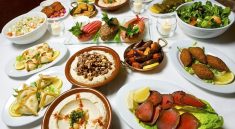Singapore is a diverse and vibrant island nation that takes great pride in its rich culture and heritage. One of the most iconic traditions that has been passed down for generations is the practice of giving longevity cakes on special occasions. This unique tradition, which originated in China, has become deeply embedded in Singaporean culture and is a symbol of well-wishes for long life and prosperity.
These cakes, also known as “shou tao” in Chinese, are intricately designed and hold great significance in celebrations such as birthdays, weddings, and other auspicious events. The tradition of longevity cakes has evolved over time, reflecting the fusion of Chinese and Malay cultures in Singapore.
From being a simple steamed bun to now being an elaborate and decorative cake, the evolution of longevity cakes is a testament to the country’s multiculturalism. In this article, we will delve into the history, symbolism, and cultural significance of longevity cakes in Singapore, uncovering the true essence of this unique tradition that has stood the test of time.
A symbol of longevity: the significance of longevity cakes in Singapore’s cultural heritage.
The significance of longevity cakes in Singapore goes beyond its symbolism of longevity and prosperity. These cakes also hold cultural and historical significance, reflecting the country’s diverse heritage. The tradition of gifting longevity cakes originated in China, but over time, it has evolved to incorporate influences from Malay culture as well.
For instance, in Malay culture, “kek lapis” or layered cakes are often served during special occasions, and this has been incorporated into the design of longevity cakes in Singapore. This multicultural fusion is a testament to the country’s harmonious coexistence of different cultures and traditions, making longevity cakes not just a symbol of longevity but also a representation of Singapore’s cultural diversity.
Delightful delicacies: exploring the flavors and ingredients of traditional longevity cakes.
One of the most notable ingredients in longevity cakes is the use of red dates, which are believed to have medicinal properties and are known for their anti-aging benefits. Other popular ingredients include lotus seeds, dried longan, and goji berries, all of which are believed to promote good health and longevity.
The cakes are also often flavored with pandan leaves, a staple in Malay and Southeast Asian cuisine, which adds a unique and fragrant taste to the cakes. These carefully selected ingredients not only add to the flavor of the cakes, but also hold cultural and symbolic significance, making longevity cakes a true representation of Singapore’s rich heritage.
Time-honored traditions: the art of crafting and presenting longevity cakes in Singapore celebrations.
The art of crafting and presenting longevity cakes is a time-honored tradition in Singaporean celebrations. These cakes, also known as “shou tao” in Chinese, hold a special significance in Chinese and Malay cultures as they are believed to bring good luck, health, and longevity to the recipient.
The process of making a longevity cake involves careful selection of ingredients, intricate shaping and decorating techniques, and a deep understanding of cultural symbolism. This tradition not only showcases the culinary skills of the baker, but also serves as a way to honor and show respect to elders in the community. The presentation of a beautifully crafted longevity cake is a gesture of well-wishes and blessings for a long and healthy life.
Celebrating milestones: how longevity cakes play a role in birthdays and other special occasions.
The tradition of longevity cakes originated from the belief that by consuming them, one will be blessed with a long and prosperous life. Thus, they are often served during important occasions such as birthdays, weddings, and anniversaries as a way to wish the celebrant a long and fulfilling life.
The preparation of a longevity cake is a meticulous process that involves experienced bakers and skilled artisans. The cake is usually made with ingredients that symbolize longevity and good fortune, such as red bean paste, lotus seeds, and longan fruit. The cake is then shaped into a peach, which is a symbol of longevity in Chinese culture. The final touch is the intricate decorations, which often include auspicious Chinese characters and intricate designs made with colored icing.
The presentation of a longevity cake is just as important as its taste, as it reflects the high regard and respect for the person being celebrated. Hence, it is no surprise that longevity cakes continue to be an essential element in Singaporean celebrations, serving as a symbol of good wishes and blessings for a long and prosperous life.
Preserving heritage: the importance of passing down the tradition of longevity cakes to future generations.
Preserving heritage is crucial in maintaining our cultural identity and passing down traditions to future generations. In Singapore, one tradition that holds significant importance is the consumption of longevity cakes during special occasions. These cakes, with their unique ingredients and symbolic shapes, not only bring joy and sweetness to the celebrations but also serve as a reminder of the value placed on longevity in our culture.
By passing down the tradition of longevity cakes, we are not only preserving our cultural heritage but also instilling the importance of longevity and well-being in our younger generations.
As society progresses and becomes more modernized, it is easy for traditional practices to be forgotten or replaced. However, by continuing to make and serve longevity cakes, we are keeping alive a tradition that has been passed down for generations and reinforcing its significance in our culture. In this way, we are honoring our ancestors and ensuring that this tradition will continue to be cherished and celebrated by future generations.





